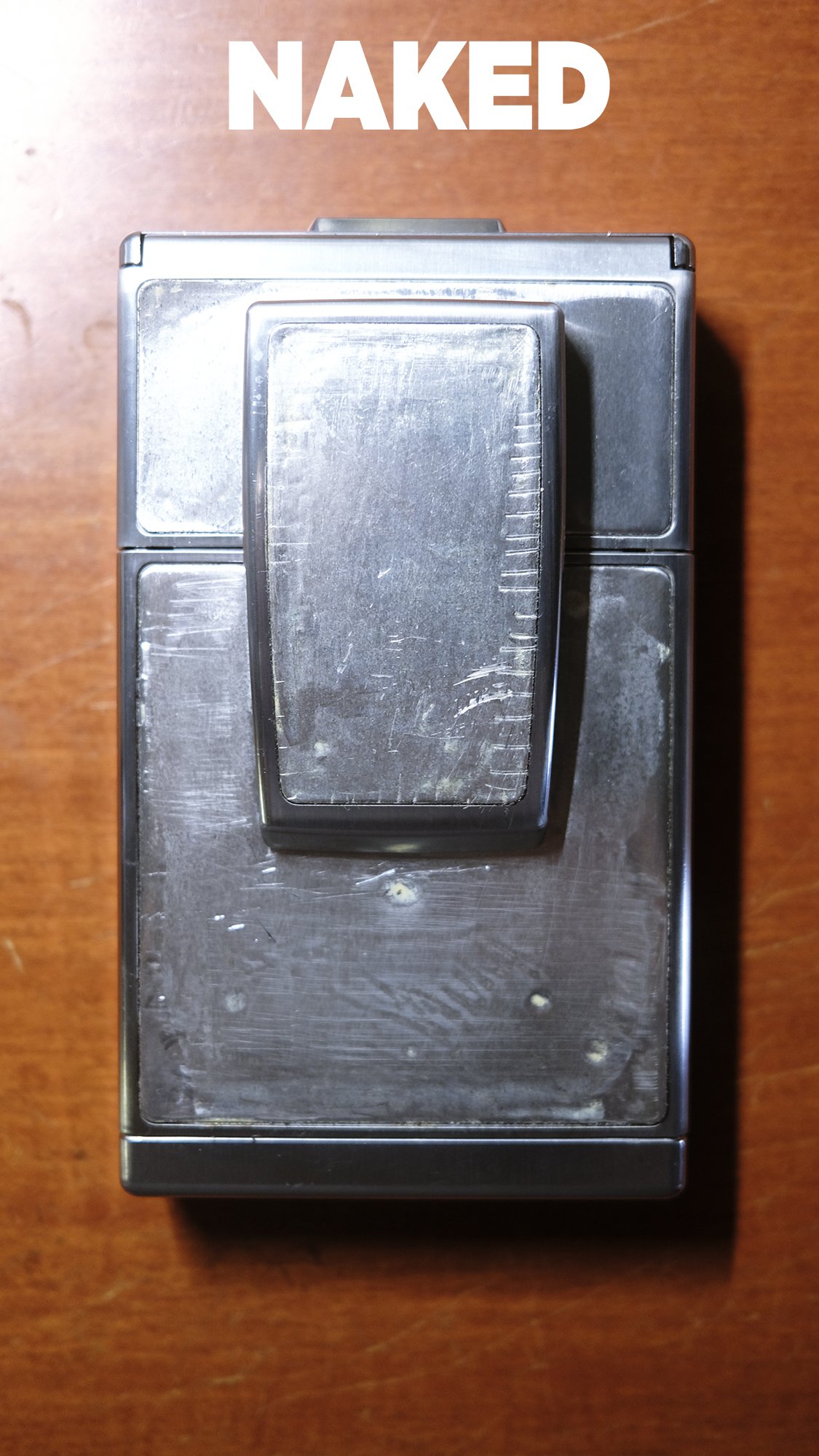I’ve always mucked around with instant film of some kind but the last few months I’ve really been digging in and enjoying shooting with my Polaroid cameras, and I thought I’d talk a little bit about my history with instant film.
As luck would have it, there actually exists a photograph of the very day I was shown my first instant film. I was six or seven I think. Of course it was a Polaroid:
Sid. Holding his first polaroids. Being amazed at an instant photograph.
I think it was my uncle that had the camera. There are still a few Polaroids in my possession from that day, and the image above is one of them. I can’t remember what type of camera is was, but being held something that didn’t have an image and then suddenly I see myself develop into view and I was hooked. My little kid brain couldn’t understand what the hell was going on.
I think for a birthday soon after I got a polaroid camera. Big and square and boxy and my mom would put the packs in the camera for me and I’d run to her when it stopped spitting out pictures to get more. I’d run out into the woods with my action figures and set up battles and make Polaroids of them - images now long gone and lost, but instant film fascinated me.
Here I am at 19 years old, working at Lechmere and hanging around the photography department.
When I went back to college around the year 2000, I got back into shooting more pack film as I was picking up film cameras that I could get instant film pack backs for.
Sara in the back of the Jeep • Mamiya RB67 with instant back
At some point I stocked up on Fujifilm FP-3000B, a high speed pack film. Sometime in the mid 2000’s Fuji decided it was time to retire pack film and I watched things like FP-100C vanish in front of my eyes. So I picked up around sixty boxes of FP-3000B before it was too late, and throughout the 2000’s and 2010’s I’d occasionally bring a pack film camera along with me somewhere.
Our pet Narcolyptic Owl, created by artist Heidi Brunelle.
Sara in old studio • Hasselblad 500C/M
Our Honeymoon cabin • Polaroid Land Camera Automatic 210
Abandoned car in Pittsburg NH • Hasselblad 500C/M
I love shooting pack film but I’m always frustrated by the camera I’m using. For example, I love shooting with my Hasselblad, but as you can see with the examples up above, shooting instant film only uses a portion of the pack film - that’s because of the Hasselblad’s square format, and it’s cool that they made backs for the Hasselblad, but I’m always frustrated that it doesn’t use the whole image area. I love using something like a big Polaroid Land Camera, but they are big and clunky and clumsy and cumbersome to use and so I didn’t use them all that often.
I do love Fuji’s Instax film. I can shoot images on my X100 camera and then wirelessly make little prints to the SP-2 printer. That’s pretty awesome and I’ve used that in the past when working with someone and I can spit out a print or two to leave behind.
Piles of instant prints; Fuji Instax and Polaroid SX-70 and Polaroid 600 and Fuji FP-3000B. These are the ones not in photo binders.
I was never a huge SX-70 fan; I never had one growing up or while I was in college. My first experience with the SX-70 style cameras was when my Father-in-Law gave me his, which I instantly put puppet clothes on and took portraits of:
He’s so punk.
This was at a time when Polaroid went out of business and Impossible Project still hadn’t fully materialized yet. So it was more of a novelty piece I had on display at my photography studio more than anything else.
A photographer friend gifted me a really nice SX-70 camera with a case and a flash bar and a pack of Impossible Project PX 680 film. The Impossible Project had been out for a short while and people were starting to talk about it and the resurgence of instant film. It was a quiet but interesting time hearing rumors about these old Polaroid technicians buying equipment so they could bring back Polaroid style instant film.
My unopened pack of PX 680 by then-branded Impossible Project.
Cut to more recently. I’m working at Photo Retro and we start stocking instant pack film by Polaroid Essentials but now fully rebranded as Polaroid. We’ve been stocking SX-70 film in both color and black & white variants, as well as 600 film in color and b&w. I’ve starting to get the itch to buy a few boxes and pop them in my SX-70’s to make sure they still work. I do, and pick up a few packs and both of the SX-70’s fire up and work great!
Okay, so now I’m getting jazzed and I start looking at the SX-70’s I have and notice that the leatherette on them are looking pretty gross and, boy, would it be awesome to re-skin the leather on the cameras like I do with my old X100 cameras.
And wouldn’t you know it - they make replacement leather kits for SX-70 cameras.
I hopped over to Etsy and bought one olive colored skin so I could try re-skinning one of the cameras. Just to see how involved it might be.
Oh good lord, what a mess.
The above shows the original look of the SX-70 followed by it completely de-skinned and the last image shows the new olive leatherette on.
note: after going back I discovered I hadn’t taken all the necessary stuff off before putting the new skin on, so I need to remove the new skin, remove more of the old leatherette plate, and then apply another new skin on it
After feeling comfortable doing the first SX-70 I started working on the 2nd camera I had.
THE DIFFERENT TYPES OF SX-70 CAMERAS
(To learn more about the history of the SX-70 camera line, head over to this Wikipedia article. To learn more about the various body-types and models of the SX-70, check out this comprehensive list over at Instantoptions.com)
The first camera I re-skinned was an original SX-70 Land Camera. These early versions had a silver metal shell as opposed to the Alpha 1 Model 2 camera that I have, which has a plastic black body base, making it lighter to hold. The later version also use a generic leatherette called “Porvair” which is completely garbage. I’ll explain more below …
The first model I replaced with the metal body was very easy to remove the leatherette from - mainly because the leather was fused to a thin metal-like plate that also came up with the leather. With gentle pulling you could remove the leather more or less in one giant piece, then having to go in and remove whatever adhesive didn’t come up with the metal plate and leather.
And here are some behind-the-scenes shots while removing the leatherette from plastic model with the Porvair leatherette:
Here we go
When Polaroid moved to the cheaper-to-manufacture Alpha line of SX-70’s, they substituted the metal frame for a plastic frame and in doing that switch, they also moved over to this Porvair leather. When you attempt to remove the Porvair, it crumbles into a bajillion pieces. It’s extremely messy and very frustrating to remove because it just crumbles away. My advice is to take it really slow. I started by using a razor blade scraper and going very gently right under the leather and pulling up as I went. It crumbled into millions of pieces, but I kept at it. They key here is to go really gently. You don’t want to cut into anything important under the plastic.
After getting most of the Porvair off, I used q-tips and goo-gone and would give it light coats and let it seep in for a few minutes and then start going at the glue with the razor scraper
scrape. scrape. scrape.
I did this step many times. Apply goo-gone, wait, scrape. Apply more goo-gone, wait, scrape.
Also: make sure you wear protective gloves while doing this. Keep your hands safe.
I went through about 6 or so razor blades while doing the 4 cameras I have. I wanted a nice sharp edge on my knife as I was removing the leather.
looking pretty good.
While I was doing all this de-skinning I was keeping my eyes open to see if I could find any more variant camera bodies to add to my arsenal, and I lucked out not once but twice.
The first was I found a SLR 680 model for a very good price. The SLR 680 cameras were just about the last SX-70 model released by Polaroid, and these cameras took 600 pack film instead of SX-70 pack film. These 680 cameras are rarer in numbers and feature Sonar auto focus and have a built in tilting flash unit. They are very swanky.
I also found an SX-70 Sonar camera at a thrift shop for $8. I tossed a fresh pack in and the camera fired right up.
Currently my Polaroid camera family consists of:
SX-70 Land Camera
SX-70 Alpha 1 Model 2
SX-70 Sonar
SLR 680
I also picked up to plastic, boxy-style cameras, like the one I remember my uncle showing me back when I was a kid. These are the Pronto! (the first non-folding style Polaroid camera) which takes SX-70 film, and the OneStep 600, which takes 600 film.
Pronto!
OneStep 600
Not a bad little family, eh?
Re-skinned SX-70, and the rest waiting for new skins.
The two boxy-style Polaroids: (L) the Pronto! takes SX-70 film. (R) The OneStep 600 takes 600 film.
Here are the four folding cameras now that all the skins have been applied:
A few weeks ago we headed up to Northern New Hampshire to stay at a friends camp. I brought one of the boxy Polaroids with me while the new skins for the SX cameras were still in the mail. I had just received some of the Color 600 Film Round Frame so I wanted to play around with it.
These were taken with the OneStep 600. These boxy Polaroid cameras have a plastic lens, so the images aren’t going to be as sharp as the ones with the SX bodies, which use glass lenses. But, still, these are awesome. I LOVE the round frame. It has such a fantastic feel and look to it. I’m really looking forward to tossing some of this in the SLR680 and taking shots - I think they are going to look fantastic.
As I write this, I’m getting ready to head down to the Outer Banks in North Carolina and I’m going to be bringing my SX-70 Sonar and my SLR680. I already stocked up on Polaroid film, and I’ll be bringing some of that with me.
current stock of Polaroid film
I’m really excited to shoot with these. Just like when I was a kid, I love the magic of watching a print spit out right after I took it; something tangible and real, and, like my memories so often are, just a little bit fuzzy.
Let me know if you have any questions. I love talking about this stuff!




























